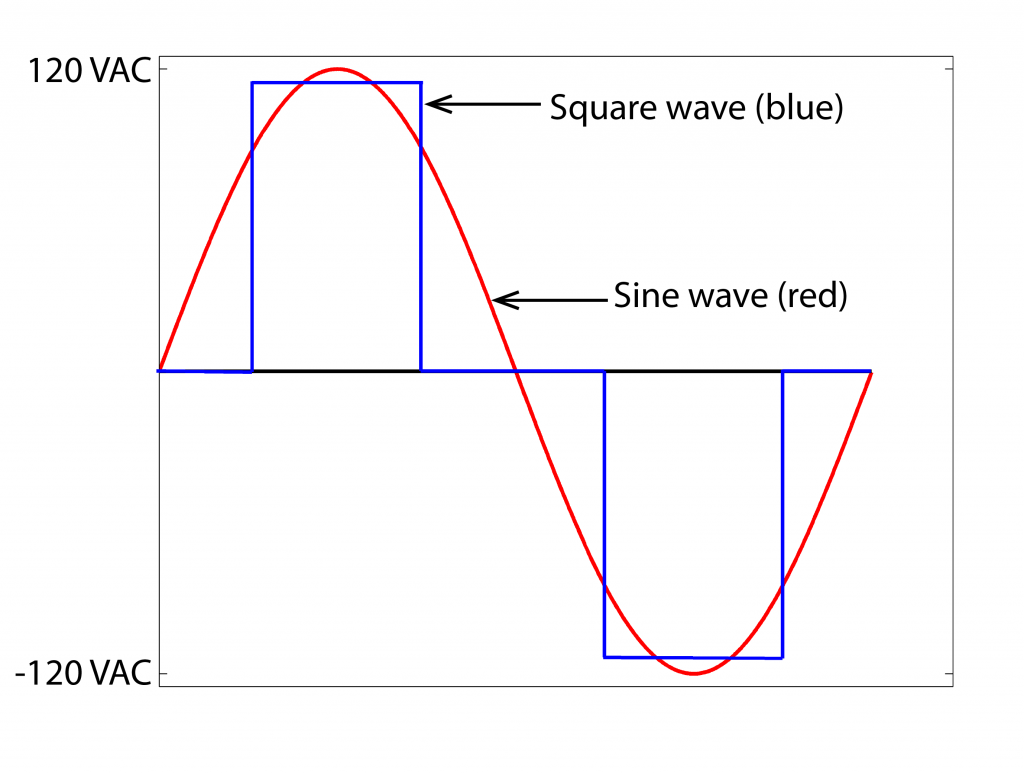
Inverters are used to convert from a lower voltage to the standard 120VAC (220VAC in Europe) used to run appliances, electronics, motors, pumps, and other devices. Most appliances use alternating current (VAC).
Inverters used in renewable energy projects typically have power ratings from 50W up to 5kW. This rating refers to an inverter’s continuous power supply. For example a 100W light bulb would need an inverter with a continuous power rating of 100W, or 4 of these light bulbs would need a 400W inverter. The inverter surge rating is the maximum power it can supply in a short period of time. This would be the case for motors, pumps, etc. or when using multiple devices that require more power when added than the inverter can continually supply.
Types of Inverters
There are two main types of inverters: Pure Sine and Modified Sine wave.
Electricity in VAC form can be visualized as a sine wave as shown on the image below in red. The closer to this wave form, the better the performance from your appliances, electrical devices, etc. is going to be. Pure Sine wave inverters have this type of wave. Modified sine wave inverters on the other hand have a square wave as shown on the image in blue, meaning that they are less efficient.

The table below summarizes these two types of inverters
| Pure Sine Wave | Modified Sine wave | |
| Efficiency | depends on power draw and size of inverter | Appliances may use 20% more power to run compared to a Pure Sine wave inverter |
| Use | Works well on all electronic equipment. Recommend for powering sensitive electronics or variable speed motors. | Can be used on most appliances, power tools, motors, pumps, etc. Appliances like refrigerators and AC units will consume more power due to the modified wave. Florescent light bulbs, digital clocks and temperature sensors might not work correctly. |
| Cost | These inverters are more expensive; on average, one can expect to pay 2x to 3x more than Modified Sine wave inverters | Cheaper than Pure Sine wave inverters. |
Inverter efficiency is the relationship between the amount of power going into the inverter and how much of that comes out as AC current. The efficiency will vary depending on type, model and the power draw of the inverter. For example, a 200W inverter will be more efficient under loads close to 200W compared to running a 5W radio.
Inverter Chargers
These can draw energy from your batteries like a typical inverter but can also charge the batteries either from a generator or from an electrical outlet (like a battery charger). They come in either Pure Sine or Modified Sine wave form. We recommend using them when combining renewable energy sources with gasoline/diesel generators.
Contact us for more information.
Inverters for Refrigerators and Induction Motors
Most refrigerators have compressors that operate using induction motors. These motors require very large starting currents for a very short amount of time (a second or less). When selecting an inverter to run a refrigerator it has to be able to supply this peak power. A general rule of thumb when selecting an inverter is to multiply your refrigerator’s average power draw times a factor of 4 (can vary from 3 to 5). The first step is to look at the refrigerators electrical rating (found in the user’s manual or sometimes inside the refrigerator). Let us say the rating is 4.0A then using the 4X rule, the starting current is 4 x 4.0A = 16.0A. Power is equal to Voltage x Current, then at 16.0A and 120VAC the starting power draw is approximately 1920W (let us use 2000W instead). In this case we have two options: 1) pick and inverter with a continuous power rating of 2000W or 2) pick an inverter that is capable of supplying a 2000W surge.
From our tests on Energy-Star refrigerators made within the last 6 years, in general, a 1000W-1500W continuously rated Pure Sine inverter worked well for running 12 cu. ft. to 18 cu. ft refrigerators, and a 600W pure sine inverter for a smaller 6 cu. ft refrigerator. We suggest contacting your refrigerator manufacturer and ask about running from an inverter.
